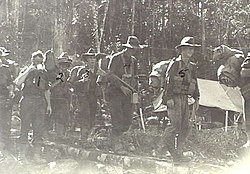| 57th/60th Battalion | |
|---|---|
 Men from the 57th/60th Battalion advance up the Faria River in February 1944 | |
| Active | 1930–46 |
| Country | |
| Branch | Australian Army |
| Type | Infantry |
| Size | ~800–900 men[Note 1] |
| Part of | 15th Brigade, 3rd Division[Note 2] |
| Nickname(s) | Merri/Heidelberg Regiment |
| Motto(s) | Hard'n'Bold[Note 3] |
| Colours | Black alongside red |
| Engagements | Second World War |
| Insignia | |
| Unit colour patch |  |
The 57th/60th Battalion was an infantry battalion of the Australian Army which served during the Second World War. It was formed in 1930 as part of the Militia by the amalgamation of the 57th Battalion and the 60th Battalion.
It was assigned to the 15th Brigade, 3rd Division in Victoria. Following the outbreak of the war, the battalion was initially used in a garrison role in Australia before being deployed to New Guinea in March 1943. The 57th/60th performed garrison and engineering roles at Tsili Tsili Airfield in the Watut Valley, while the rest of 15th Brigade took part in the Salamaua–Lae campaign, following which the 15th Brigade including the 57th/60th was formed up for battle in its entirety. Command was transferred to the 7th Division and the 15th Brigade including the 57th/60th then fought in the Markham and Ramu Valley and the Finisterre Range campaigns.
The 57th/60th Battalion remained in New Guinea until July 1944 before being brought back to Australia for home leave, further training and reorganisation.[4] Command of the battalion along with the rest of the 15th Brigade was transferred back to the 3rd Division, and the battalion embarked for Bougainville in January 1945 where Australian forces had replaced the Americans, taking part in the advance towards Buin through the southern sector of the island until early July 1945, at which time they were relieved by the 15th Battalion.
Following the end of hostilities the battalion was gradually demobilised and was finally disbanded in March 1946. The battalion colours (of the 57th Battalion and the 60th Battalion) are laid up in the crypt of the Shrine of Remembrance in Melbourne, Australia.
Cite error: There are <ref group=Note> tags on this page, but the references will not show without a {{reflist|group=Note}} template (see the help page).